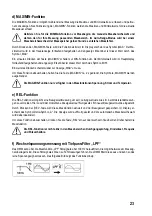
37
5. Safety instructions
• These instructions contain important information on how to use the multimeter correctly. Please read
them carefully before using the multimeter for the first time.
• Damage caused due to failure to observe these instructions will void the warranty. We shall not be liable
for any consequential damage.
• We shall not be liable for damage to property or personal injury caused by incorrect handling or failure to
observe the safety information! Such cases will void the warranty/guarantee.
• This device was shipped in a safe condition.
• To ensure safe operation and avoid damaging the device, always observe the safety information and
warnings in these instructions.
• The unauthorized conversion and/or modification of the device is not permitted for safety and approval
reasons.
• Consult a technician if you are not sure how to use or connect the device, or if you suspect that the device
is not safe to use.
• Measuring instruments and their accessories are not toys and must be kept out of the reach of children.
• Always comply with the accident prevention regulations for electrical equipment when using the product
in commercial facilities.
• In schools, educational facilities, hobby and DIY workshops, measuring devices must be operated under
the responsible supervision of qualified personnel.
• Before each measurement, make sure that the device is not set to a different measurement range.
• When using test leads without protective caps, measurements between the
multimeter and the earth potential must not exceed the CAT II measurement
category.
• When taking CAT III measurements, the cover caps must be placed on the
probe tips to avoid accidental short circuits.
• Push the cover caps onto the probe tips until they click into place. To remove the
caps, pull them off the tips with some force.
• Always remove the test probes from the measured object before changing the measurement range.
• The voltage between the multimeter connection points and earth must never exceed 600 V in CAT III.
• Exercise particular caution when working with voltages higher than 33 V (AC) and 70 V (DC). Touching
electrical conductors with these voltages may cause a fatal electric shock.
• To prevent an electric shock, do not touch the measuring points when taking measurements, either
directly or indirectly. When taking measurements, do not touch any area beyond the grip markings on the
test probes and the multimeter.
















































